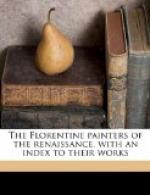[Page heading: VERROCCHIO’S LANDSCAPES]
Verrocchio was, among Florentines at least, the first to feel that a faithful reproduction of the contours is not landscape, that the painting of nature is an art distinct from the painting of the figure. He scarcely knew where the difference lay, but felt that light and atmosphere play an entirely different part in each, and that in landscape these have at least as much importance as tactile values. A vision of plein air, vague I must grant, seems to have hovered before him, and, feeling his powerlessness to cope with it in full effects of light such as he attempted in his earlier pictures, he deliberately chose the twilight hour, when, in Tuscany, on fine days, the trees stand out almost black against a sky of light opalescent grey. To render this subduing, soothing effect of the coolness and the dew after the glare and dust of the day—the effect so matchlessly given in Gray’s “Elegy”—seemed to be his first desire as a painter, and in presence of his “Annunciation” (in the Uffizi), we feel that he succeeded as only one other Tuscan succeeded after him, that other being his own pupil Leonardo.
X.
[Page heading: GENRE ARTISTS]
It is a temptation to hasten on from Pollaiuolo and Verrocchio to Botticelli and Leonardo, to men of genius as artists reappearing again after two generations, men who accomplished with scarcely an effort what their precursors had been toiling after. But from these it would be even more difficult than at present to turn back to painters of scarcely any rank among the world’s great artists, and of scarcely any importance as links in a chain of evolution, but not to be passed by, partly because of certain qualities they do possess, and partly because their names would be missed in an account, even so brief as this, of Florentine painting. The men I chiefly refer to, one most active toward the middle and the other toward the end of the fifteenth century, are Benozzo Gozzoli and Domenico Ghirlandaio. Although they have been rarely coupled together, they have much in common. Both were, as artists, little more than mediocrities with almost no genuine feeling for what makes painting a great art. The real attractiveness of both lies entirely outside the sphere of pure art, in the realms of genre illustration. And here the likeness between them ends; within their common ground they differed widely.




